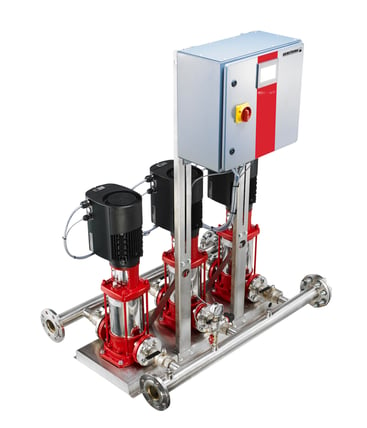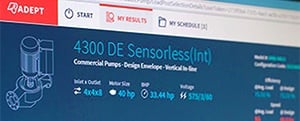A domestic water pressure booster system is essential for buildings with inadequate supply pressure from the city or buildings served from storage tanks. A booster ensures potable water is available at appropriate pressures on every level of a building. Because flow demand in most buildings is highly variable, variable frequency drives and automatic controls are an excellent option to reduce the energy used to maintain constant pressure.
Here are answers for three of the most common questions about water pressure booster pumps.
Which buildings needs a water pressure booster pump?
Typically, buildings over four stories experience inadequate water pressure on the upper floors. This is a design challenge for many apartments and condos, office towers, mixed use properties, hospitals, hotels, and schools.
This is because most municipalities provide water at a pressure level that is enough to push potable water to the fourth floor. The higher you are above source, the more gravity reduces the pressure available at the tap. So, the third floor will have slightly less pressure than the second floor, and the fourth floor will have slightly less pressure than the third floor. For any floors above the fourth floor, the pressure loss due to gravity reduces water pressure (and flow) below an acceptable level for operating faucets, bathtubs, showers, and toilets.
Some older buildings may also need a booster pump because changes to the plumbing code require the addition of a backflow preventor. Adding a backflow preventor valve can cause a pressure loss of 7-10 psi. That might correlate to inadequate pressure across two floors. A booster pump will overcome this deficit and restore the correct pressure.
Are domestic water pressure booster pumps used for retrofits?
Absolutely, and especially if the retrofit involves upgrading from a constant speed booster.
Retrofits represent a sizable segment of the current market activity around booster installations. If a building was constructed 15-20 years ago, it likely uses a constant speed booster. Even if an existing booster system is still operating it’s a good idea to switch to a smart system with a variable frequency drive (VFD) because the savings in water and energy as well as maintenance will pay for the replacement in 1 – 2 years.
There may even be incentives or rebates available from your utility provider or municipality. For example, Ontario’s Save on Energy program offers a $300 rebate per horsepower for variable speed domestic cold water booster pump systems.
Can a domestic water pressure booster pump save money?
Yes. A variable speed booster system is an energy-efficient alternative to a constant speed pump, especially because existing booster pumps are very often oversized. A variable speed booster pump with permanent magnet motors and intelligent controls from Armstrong, increases savings up to 15% more than a standard variable speed unit
A variable speed booster package uses intelligence to modulate output in response to demand. The boosters controls register whenever a tap is in use and increase speed to maintain endpoint pressure. Rather than operating nonstop, an intelligent pump is only active when usage occurs. This results in significant energy savings and water savings. Permanent magnet technology allows boosters to react much faster to changes in demand which increases occupant comfort while decreasing maintenance requirements compared to traditional variable speed boosters
It’s important to recognize that every building experiences unique fluctuations in demand for water. For example, water demand in a high-rise residence increases during the morning and evening but decreases in the afternoon. Whereas in an office or school building, demand is steady throughout the day with peaks occurring during lunch, but is nonexistent in the evenings and on weekends. An intelligent variable speed booster adjusts automatically to match these fluctuations.
However, a constant speed pump with a pressure reducing valve won’t recognize and adjust output to match these fluctuations in demand for water. As the name suggests, constant speed pumps operate continuously, regardless of water demand. Oversized booster pumps, even with a VFD, also consume excessive electricity due to frequent cycling which also leads to exorbitant maintenance costs.
A right-sized booster package with a VFD and smart controls is the best way to conserve energy, deliver appropriate water pressure to end users, and avoid unnecessary wear.
Armstrong Fluid Technology offers two models of booster pumps for both new construction and retrofits. The Design Envelope 6800 Vertical Multi-stage Booster is for mid-sized to large buildings, while the Design Envelope 6900 Dualpak Booster is for mid-sized properties. Both have integrated, intelligent controls that provide up to 70% in energy savings over traditional constant speed and hybrid booster systems.



